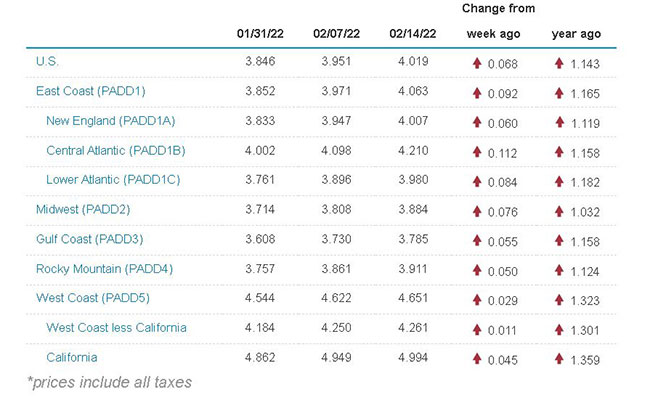Senior Reporter
Diesel Tops $4 a Gallon With 6.8¢ Hike

[Stay on top of transportation news: Get TTNews in your inbox.]
Diesel eclipsed $4 a gallon for the first time in nearly eight years, with a 6.8-cent jump pushing the national average to $4.019, according to Energy Information Administration data released Feb. 14.
The last time a gallon of diesel cost at least as much as its current price was March 10, 2014, when it was $4.021. The cost of a gallon of diesel has surged 40.6 cents over the past six weeks.
Trucking’s main fuel now costs $1.143 more than it did at this time in 2021.
On-Highway Diesel Fuel Prices

EIA.gov
Diesel’s price rose in all 10 regions in EIA’s weekly survey, with the largest increase 11.2 cents in the Central Atlantic. The price of gasoline grew by 4.3 cents a gallon nationally to reach $3.487.
Two of the nation’s leading energy analysts told Transport Topics that gas and diesel prices may keep increasing, possibly to the level of the spring and summer of 2008, when unleaded regular gas reached $4.11 a gallon and diesel climbed above $5.

Kloza
Oil Price Information founder Tom Kloza told TT that the continuing uncertainty over Russia’s possible invasion of neighboring Ukraine is pushing energy prices higher. He also believes the recent extreme cold weather, not only in the U.S. but worldwide, caused a surge in demand for home heating oil and natural gas.
“I would say a lot of it was the cold winter,” Kloza said. “I watched a lot of diesel molecules go into heating purposes, whether it was for heating oil or whether it was generating electricity, some in Europe, some of Asia and a bit in the Northeast, and the heating degree days were higher recently.”
Heating degree days are a measure of how cold the temperature was on a given day or during a period of days. Data from the American Gas Association indicated the extent of the cold snap, since the beginning of the year, as heating degree days were 14.5% higher this January compared with the same month in 2021. And the first week of February showed a 12.7% heating degree day increase compared with 2021.

Flynn
Oil analyst Phil Flynn told TT that one of the factors driving higher diesel prices is the 11.5% year-over-year lower inventories for Jet A fuel, which are declining as airlines begin more flights with signs the pandemic is easing. From a refining and molecular standpoint, Jet A and diesel are almost identical.
“We know right now there has been a global shortage of diesel,” Flynn said. “You’ve got the reopening of trade, inventories are way below average and the refineries can’t keep up. The competition is coming back from the airlines with the air travel really starting to perk up. So it’s a really tight supply situation.”
An EIA report Feb. 15 indicates another factor is causing higher diesel prices. It has to do with the now 2-year old International Maritime Organization requirement that cargo ships abandon dirty, high-sulfur “bunker fuel” and instead use a much lower sulfur fuel, which often is blended with diesel to comply with the regulation that went into effect Jan. 1, 2020. EIA said demand for low-sulfur fuel is up 86% from an estimated 230,000 barrels per day to 430,000 barrels per day Feb. 4.
#TodayInEnergy - U.S. crude #oil production forecast to rise in 2022 and 2023 to record-high levels #STEO https://t.co/HO7zO40AUy pic.twitter.com/DQy6rUtFMR — EIA (@EIAgov) February 16, 2022
Demand for diesel is increasing because more ships are transporting goods worldwide. According to DHL Freight Forwarding, the international container liner fleet grew 4.5% in 2021 as shipping prices surged worldwide, especially on the lucrative China-to-Southern California route.
But there are signs with prices for oil increasing, production is ramping up. As the price of West Texas Intermediate crude oil increased 54% in the past year from $60.05 a barrel Feb. 15, 2021, to $92.45 a barrel on Feb. 15, 2022, domestic oil exploration is expanding.
The Baker Hughes Rig Count, a weekly survey that monitors the number of active rigs nationally and internationally, showed a 60% year-over-year increase in domestic rigs, climbing to 635 the week ending Feb. 11, compared with 397 in 2021.
Want more news? Listen to today's daily briefing above or go here for more info
Crude oil production is set for another increase next month, according to the U.S. Energy Information Administration’s latest edition of the Drilling Productivity Report released Feb. 14.
The report, which tracks crude oil production, said crude oil production in the seven most prolific U.S. shale basins is set to increase to 8.70 million barrels per day in March, up 109,000 barrels per day, or 1.3%, from February’s 8.59 million barrels per day, and an increase of 271,000 barrels per day from January’s tally.
EIA said the largest increases are expected in the West Texas and Eastern New Mexico region’s Permian Basin, which could see a jump of 71,000 barrels per day, and the Eagle Ford Basin, in South Texas, which stretches across much of the state from the U.S.-Mexico border to Waco. Production there could increase by 24,000 barrels per day.

